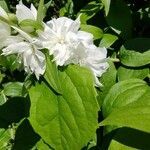Shrubs 10–30 dm. Branches erect to ascending. Leaves: petiole 1–3 mm, sparsely to densely stellate-pubescent; blade ovate-lanceolate to ovate, 30–80 × 15–50 mm, base rounded or broadly cuneate, margins crenate-denticulate, apex acute to acuminate, abaxial surface light green, densely stellate-pubescent, trichomes 10–20-rayed, adaxial dark green, stellate-pubescent, trichomes 4–6-rayed. Inflorescences racemes or panicles, loose, 5–50-flowered, 4–10 × 2–3 cm, stellate-pubescent; peduncle absent. Pedicels 2–10 mm, sparsely stellate-pubescent. Flowers faintly fragrant, 8–20 mm; hypanthium campanulate, 2.5–5 × 3–4 mm, densely stellate-pubescent; sepals triangular to ovate, 1.5–2.5 × 1–2.2 mm, apex obtuse, surfaces stellate-pubescent; petals valvate, white or pinkish, narrowly elliptic to oblong, 7–15 × 2.5–3 mm, stellate-pubescent abaxially, glabrous or sparsely stellate-pubescent adaxially; filaments dorsiventrally flattened, narrowly oblong, outer 7–9 mm, apex 2-lobed, inner 5–6 mm, apex 2-lobed; styles 3(–4), 5–11 mm. Capsules 3.8–5 × 4–5 mm. Seeds 1.5–2 mm. 2n = 26, 130 (Asia).
More
A large upright shrub. It grows to 3 m tall. The canes are thick. They arch over. The leaves are dull green and rough textured. The flowers occur in white panicles. The flowers are white or pink tinted. They are bell shaped and at the ends of branches.
A shrub with opposite lvs, regular, perfect (sometimes double) fls, 10 stamens, and 3–5 styles, rarely escapes from cult.









